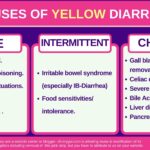Lactose Intolerance Stool Changes (Color, Smell, Mucus, Consistency, etc.).
Our content is not intended nor recommended as a substitute for medical advice by your doctor. Use for informational purposes only.
Key Facts:
- Lactose intolerance stool changes are more prominent in children than adults.
- These stool changes are not specific for lactose intolerance, as you may have a normal stool. Also, they may occur in various other conditions, such as IBS and celiac disease.
- The most common stool color change in patients with lactose intolerance is a light brown or yellowish color due to the speeding up of stool and more water content.
- The stool, in severe cases, becomes foamy or bubbly. Mucus may also be present (especially in children).
- Consistency is often watery (diarrhea). Diarrhea often comes and goes according to the amount of lactose ingested.
- Normal or mild loose consistency is common among lactose intolerance patients, especially adults.
- Due to
1. Lactose intolerance stool color.
A. Yellow or light brown stool.
Patients with lactose intolerance have a deficiency in the enzyme lactase (present in the small intestine).
As we grow, most of us undergo a gradual decline in the lactase enzymes. This leads to the most common type of
This results in the most common type of lactose intolerance, primary lactase deficiency or (lactase non-persistence).
Primary lactase deficiency is genetically regulated and often starts to cause symptoms during adolescence and early adulthood.
As a result, your digestive system becomes less able to digest the lactose sugar, accumulating in the intestine, leading to gas and diarrhea (speeding up the stool passage).
The speeding up of stool passage through the intestine and the colon will not allow the normal processing of the stool to its normal brown color.
The lactose intolerance stool often becomes paler, appearing light brown, yellowish, or yellowish-grey.
The degree of stool color changes is often related to the amount of lactose you eat.
You can learn more about what happens if you ignore lactose intolerance in this interesting article.
Yellow stools can also occur due to a variety of causes. The most common causes of yellow stool other than lactose intolerance include (reference):
- Viral gastroenteritis.
- Giardiasis.
- Irritable bowel syndrome with diarrhea.
- Celiac disease.
- Gilbert’s syndrome.
- Too much fatty food.
- Bile acid diarrhea.
- Inflammatory bowel disease.
Learn more about the causes of yellow stool and yellow diarrhea.
B. Green poop with lactose intolerance.
Lactose intolerance often leads to recurrent attacks of diarrhea that come and go. The attacks are related to the amount you eat.
Suppose the attack of diarrhea is extreme with frequent watery stool. Lactose intolerance poop may turn green due to the passage of unprocessed green bile with the stool.
Learn more about the causes of green poop.
Food is another important factor that may cause green stool in people with lactose intolerance.
Food will likely cause your green poop color if you don’t have severe diarrhea.
Examples of foods that may cause green poop:
- Green leafy vegetables.”
- Spinach
- Kale
- Cabbage.
- Beet greens
- Romaine Lettuce.
- Blueberries.
- Green food colorings:
- Dyes or color additives.
- Green-colored ice pops.
- Greenish sodas and soft drinks
- Drink mixes.
- Natural dyes such as green grapes, cucumber, etc.
- Iron supplements.
Learn more about the possible causes of green poop.
2 . Lactose intolerance stool consistency.
Patients with lactose intolerance may have normal stool consistency with or without other symptoms such as abdominal pain, bloating, flatulence, and nausea.
Loose stool or diarrhea is also a common presentation of lactose intolerance. Severe watery diarrhea is atypical with lactose intolerance.
The changes in stool form (consistency) are often intermittent, with periods of normal stools and periods of loose stool or diarrhea.
The stool changes depend on the amount of lactose intake and several other factors, such as other foods that cause diarrhea.
3. Lactose intolerance poop smell.
Lactose-intolerant people are often unable to digest ingested lactose. As a result, it gets fermented by gut bacteria.
Patients with lactose intolerance have foul- or fishy-smelling poop due to the fermentation of the undigested lactose. Moreover, the condition is associated with foul-smelling gas (flatus).
Note that your stool may not always be a fool with lactose intolerance, as the smell depends on the amount you take and other factors such as infections and dietary changes.
. Other stool changes with lactose intolerance:
A. Mucus.
Some cases of lactose intolerance may contain whitish or yellowish mucus in the stool due to diarrhea, increased bowel movement, and irritation of the intestine and the colon.
Mucus-only stools are not typical for lactose intolerance and often indicate severe rectal inflammation, as with dysentery, ulcerative colitis, and others.
B. Foamy stool.
Lactose intolerance stool may become loose, watery, or foamy due to excess fluids and fermented lactose.
C. Constipation.
Interestingly, [up to one-third](https://www.ncbi.nlm.nih.gov/pmc/articles/PMC9105309/#:~:text=Lactose intolerance can present with constipation.,methane produced by gut bacteria.) of patients with lactose intolerance may have constipation instead of diarrhea. In addition, patients may have hard, difficult-to-pass stools when they eat lactose.
Constipation occurs in patients with lactose intolerance due to the excess production of methane gas inside the intestine (which inhibits the motility of the intestine) (reference.
- Evidence-based
- Written by a doctor.






